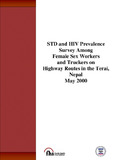Please use this identifier to cite or link to this item:
https://hdl.handle.net/20.500.14356/717Full metadata record
| DC Field | Value | Language |
|---|---|---|
| dc.contributor.author | Family Health International/Nepal | - |
| dc.contributor.author | NEW ERA | - |
| dc.date.accessioned | 2013-02-25T20:13:09Z | - |
| dc.date.accessioned | 2022-11-08T10:18:56Z | - |
| dc.date.available | 2013-02-25T20:13:09Z | - |
| dc.date.available | 2022-11-08T10:18:56Z | - |
| dc.date.issued | 2000 | - |
| dc.identifier.uri | http://103.69.126.140:8080/handle/20.500.14356/717 | - |
| dc.description.abstract | EXECUTIVE SUMMARY : Female sex workers (FSW) and truckers in the Terai region have been identified as key core group populations in the HIV/STD control plan for Nepal. In March-July 1999, a cross-sectional study was conducted along the highway routes in the Terai in an effort to determine the HIV/STD prevalence among sex workers and truckers and to determine the demographic, behavioral and biological correlates for infection. Data from this study will also be used as a baseline for evaluating control interventions, and to assist in strategic planning to reduce HIV/STD in the region. Four hundred and ten sex workers from four representative sites in the Terai and 400 truckers from one central location were enrolled in the study. Following informed consent, a questionnaire was administered, blood, urine, and self-administered vaginal swab samples were collected, syndromic STD treatment was provided, and HIV counseling was conducted. Lab analysis included HIV, gonorrhea, chlamydia, trichomonas, bacterial vaginosis, and syphilis. Subjects returned after one month for results and possible treatment. The significant findings among the sex workers included: a 70% illiteracy rate; 70% of their clients were truckers; 50% had at least one STD including 20% with syphilis; the HIV prevalence of 4% was 2.5 times the trucker rate and 13 times that of the general public; only 17% of sex workers had worked in India, but 75% of the HIV cases were from this group; only 4% had worked in Mumbai, but 50% of the HIV cases were from this group; sex workers with syphilis had a tenfold higher risk of HIV than those without syphilis. The significant findings among the truckers included: 75% reported having sex with a sex worker; 10% had at least one STD including 5.3% with syphilis; the HIV rate of 1.5% was 5 times higher than found in the general public; truckers with syphilis had a tenfold higher risk of HIV than those without syphilis; and STDs were associated with older, married men with no schooling. The implications of these finding include a continued increase in HIV rates among female sex workers, an increased HIV rate among their clients (i.e., truckers),increased secondary transmission of HIV to their steady sex partners, and because of this dynamic, a general increase in the HIV rate among the general population. The high syphilis rates among the truckers and sex workers will lead to 1/3 of those infected developing tertiary syphilis and its fatal health effects. The high rate of chlamydia will lead to 20% sterility. | en_US |
| dc.language.iso | en_US | en_US |
| dc.subject | STD and HIV Prevalence Survey Among Female Sex Workers and Truckers on Highway Routes in the Terai, Nepal | en_US |
| dc.title | STD and HIV Prevalence Survey Among Female Sex Workers and Truckers on Highway Routes in the Terai, Nepal | en_US |
| dc.type | Technical Report | en_US |
| Appears in Collections: | NHRC Research Report | |
Files in This Item:
| File | Description | Size | Format | |
|---|---|---|---|---|
| fswtruckerstdseroterainepal2002.pdf | Full Report. Download | 172.53 kB | Adobe PDF |  View/Open |
Items in DSpace are protected by copyright, with all rights reserved, unless otherwise indicated.
